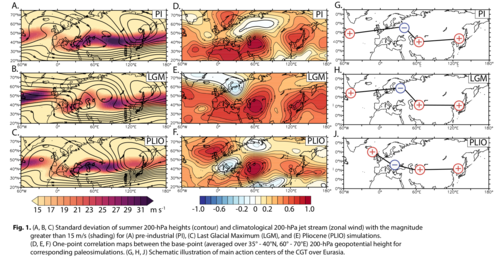Bachelor of Science (B.Sc.)
Inhalt
Description
Large-scale atmospheric circulation in the extratropics fluctuates in its own dynamics, involving nonlinear interaction among eddies with various horizontal scales and a wide range of time scales. The circumglobal teleconnection (CGT) is a major teleconnection pattern in the northern hemisphere in boreal summer and is characterized by several geographically-anchored action centers along the upper-tropospheric westerly jet stream (Ding and Wang, 2005). Alternative names for the CGT also exists in literature, such as the “Silk Road pattern”, “European wave train” for the Eurasian segments, and the “Tokyo–Chicago express” for the Pacific segment. The CGT has important impacts on the mid-latitude temperature, precipitation, and extreme weather (Bothe et al., 2011). In addition, the CGT is closely related to the monsoonal circulation in the tropics (Saeed et al., 2011). For example, there is a chain of interactions between the CGT and the Indian monsoon rainfall variability: one interaction involves the wave train that develops over the North Atlantic and modulates the monsoon rainfall activity, and another interaction involves anomalous monsoon heating influencing the downstream development of the CGT (Ding and Wang, 2005). For the paleo case, the changes in CGT under different climatic forcings, its connection to the Asian monsoons, and its impact on surface climate are not clear. In this project, we suggest exploring changes in CGT for the Pliocene (3 Ma) and the Last Glacial Maximum (LGM, 21 ka) compared to pre-industrial. The Pliocene is considered as a past analogue of future warm climate (Haywood et al., 2016) and the LGM is an example of a colder-than-present climate (Braconnot et al., 2007).
Possible research questions
1. How do slowly varying components of the climate, such as sea surface temperature (SST), greenhouse gas concentrations, ice sheets, etc. affect large-scale circulation variability and the westerly jet stream?
2. How do changes in the North Atlantic pressure gradient affect the CGT?
3. What is the relationship between the surface climate in Asia and the GCT in warm and cold climates?
Approach
We propose to investigate changes in CGT using General Circulation model (GCM) ECHAM5 experiments with boundary conditions for pre-industrial (year 1850), the Pliocene (~3 Ma), and the Last Glacial Maximum (LGM, ~21 ka). Emphasis is on analyzing completed model simulations rather than creating new model runs. Student will be asked to analyze climatological midlatitude circulation in the Northern Hemisphere based on, for example, high-level geopotential height and winds anomalies. For MSc thesis, a temporal variation of the Northern Hemisphere pressure systems will be studied using the empirical orthogonal function (EOF) analysis.
Requirements
Requirements for this project are an interest in global atmospheric circulation and paleoclimate and a willingness to communicate in English (one of the supervisors is not a German speaker). Nevertheless, the final report can be written in German. Experience with scripting languages (Python, Ferret, ncl) would be helpful, but can be acquired during the project.
References
- Bothe, O., Fraedrich, K. and Zhu, X.: Large-scale circulations and Tibetan Plateau summer drought and wetness in a high-resolution climate model, Int. J. Climatol., 31(6), 832–846, doi:10.1002/joc.2124, 2011.
- Braconnot, P., Otto-Bliesner, B., Harrison, S., Joussaume, S., Peterchmitt, J.-Y. J.-Y., Abe-Ouchi, A., Crucifix, M., Driesschaert, E., Fichefet, T., Hewitt, C. D. and others: Results of PMIP2 coupled simulations of the Mid-Holocene and Last Glacial Maximum–Part 1: experiments and large-scale features, Clim. Past, 3(2), 261–277 [online] Available from: http://www.clim-past.net/3/279/2007/cp-3-279-2007-relations.html, 2007.
- Ding, Q. and Wang, B.: Circumglobal teleconnection in the Northern Hemisphere summer, J. Clim., 18(17), 3483–3505, 2005.
- Haywood, A. M., Dowsett, H. J., Dolan, A. M., Rowley, D., Abe-Ouchi, A., Otto-Bliesner, B., Chandler, M. A., Hunter, S. J., Lunt, D. J. and Pound, M.: The Pliocene model intercomparison project (PlioMIP) phase 2: scientific objectives and experimental design, Clim. Past, 12(3), 663–675, 2016.
- Saeed, S., Müller, W. A., Hagemann, S. and Jacob, D.: Circumglobal wave train and the summer monsoon over northwestern India and Pakistan: The explicit role of the surface heat low, Clim. Dyn., 37(5), 1045–1060, doi:10.1007/s00382-010-0888-x, 2011.


